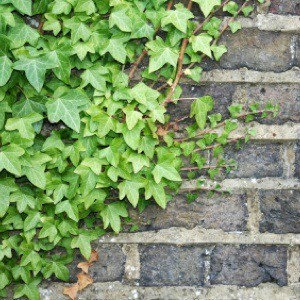 Growing climbing ivy has its pros and cons. It's easy to grow. It looks beautiful. And it can be beneficial to both the wall it's growing on, as well as to backyard wildlife.
Growing climbing ivy has its pros and cons. It's easy to grow. It looks beautiful. And it can be beneficial to both the wall it's growing on, as well as to backyard wildlife.
Unfortunately, it can also be the cause of many problems that are both costly and difficult to remedy. If you're thinking about planting climbing ivy near your house or in your garden, here are some things to consider.
Where to Grow It
It's best to grow climbing ivy on sound brick surfaces-those with cement-based mortar, and properly pointed joints. Older brick homes (pre-1930s) may have been built using different mortars from those used today.
If you have an older home, inspect the walls for existing cracks in bricks and weakened mortar before planting climbing ivy. Ivy doesn't cause mortar to crack and crumble, but if it's already unsound, it will definitely help speed up the process.
Where NOT to Grow It
- Wood: Ivy can easily work its way between wood siding, opening the joints and causing damage to the structure of the wall. The roots can also penetrate small cracks in the wood grain, and increase the risk of rot.
- Shake or Vinyl Siding: Any siding having seams (like vinyl or shakes) are vulnerable to penetration by ivy roots, which can cause damage both as the ivy is growing and when it is pulled off.
- Stucco: As with many other surfaces, climbing ivy becomes a problem on stucco when you try to remove it. When the aerial roots are removed, paint and pieces of stucco may come off with it.
- Painted Surfaces: The aerial roots are likely to damage painted surfaces when pulled off, and may cause permanent staining and discoloration.
- Trees: Ivy is very heavy. The added weight of the ivy vines makes trees more susceptible to sustaining damage (or toppling over completely) during high winds and heavy snowfalls.
The Advantages and Disadvantages to Climbing Ivy
Advantages:
- Climbing ivy is capable of thriving in dark, shady places where other plants find it difficult to grow.
- Ivy provides a thin layer of insulation on walls. It helps retain heat in the winter and keeps walls cooler in the summer, which may slightly reduce home heating and cooling costs.
- If you want to attract birds to your garden, a wall of climbing ivy can provide them with good places to perch and roost.
- For many, climbing ivy is aethetically pleasing in appearance. It's also great for covering up unsightly walls.
- Ivy has waxy leaves that shed rainwater, possibly reducing the amount of moisture coming into contact with walls, and helping to prolong the life of sound masonry.
Disadvantages:
- The tentacles and tendrils of climbing ivy can, over a period ot time, dislodge mortar and masonry.
- The aerial roots of climbing ivy may discolor the brickwork and cause permanent staining.
- Climbing ivy can harbor insect pests, birds (and bird droppings), and other animals, and provide them easy access to the interior of your house.Once established, removing climbing ivy is very difficult.
- A wall of climbing ivy can trap moisture, dirt, and debris next to building walls.
- Boston Ivy and English Ivy are considered invasive species in different parts of the country.
How Climbing Ivy Damages Trees
Climbing ivy is programmed to climb skyward toward the light. When it climbs up trees it doesn't kill them directly, but rather inadvertently. As ivy climbs toward the canopy in search of more light, it spreads across the tree's branches and prevents light from reaching the tree's leaves. It also makes pollen and seed dispersal difficult. As a result, lower branches eventually start to die back, leaving the tree with only a small amount of upper branches to carry out photosynthesis (food production). If the weakened tree doesn't succumb to insects and disease first, eventually it may die due to an incapacity to produce enough food for itself.
Maintenance
Climbing ivy on the side of a house needs to be kept well maintained and trimmed so that it doesn't start to engulf windows, doors, gutters and roof eaves, or block aeration vents.
Around windows, stems should be pruned well back from wooden frames, since ivy's aerial roots can easily work their way in between wood and wall.
Houses with exteriors made from shingles or vinyl should keep climbing ivy contained to a trellis at least a foot away from the exterior wall so aerial roots don't pry behind the siding.
Removal
If you ever decide to remove climbing ivy from a wall of your house, you need to be cautious. Test removal on a small area first to determine how embedded it is into the wall and how much (if any) damage will occur as a result of removing it. In some cases, it may be better just to leave the ivy where it is.
- To remove it, don't use chemicals. Instead, carefully cut the ivy away from the walls leaving the rootlets intact. (Pulling may damage the mortar.)
- You can wait for the rootlets to turn brown before removing them, but don't wait more than 2-3 weeks or they will harden and become very difficult to remove.
- Finally, clean the surface with a wire brush that is stiff enough to remove the remaining tendrils without harming the surface of the brick.
Comments

Cricket
Bronze Post Medal for All Time! 205 Posts March 9, 20111 found this helpful
Thank you so much for this very informative post! I had been considering planting ivy in a few of these places that you said not to. I will definitely re-think this and not plant it there!
Anonymous
December 16, 20151 found this helpful
guess I better get it off of my trees.....I want the ivy beds, so I guess just cut the trendles that go up the tree and let it die, then just keep it cut back from stuff
 Growing climbing ivy has its pros and cons. It's easy to grow. It looks beautiful. And it can be beneficial to both the wall it's growing on, as well as to backyard wildlife.
Growing climbing ivy has its pros and cons. It's easy to grow. It looks beautiful. And it can be beneficial to both the wall it's growing on, as well as to backyard wildlife.